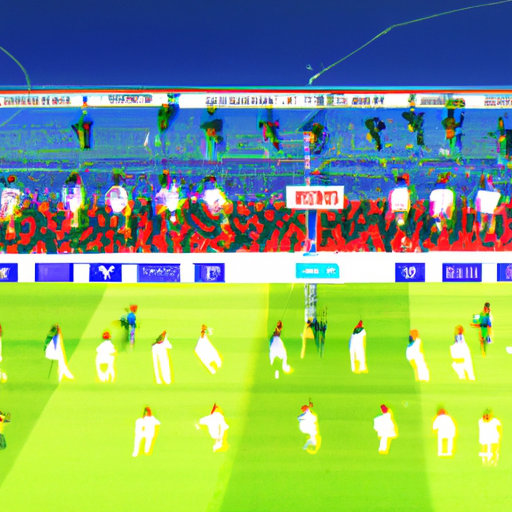World Cup runneth over

The Impact of the World Cup on Global Economy
The World Cup, the most prestigious tournament in international soccer, has a significant impact on the global economy. This sporting event, held every four years, brings together teams from around the world to compete for the coveted trophy. While the primary focus is on the athletic prowess and skill of the players, the World Cup also has far-reaching economic implications.
One of the most obvious ways in which the World Cup impacts the global economy is through tourism. The tournament attracts millions of fans from all corners of the globe, who travel to the host country to support their teams and experience the excitement firsthand. This influx of tourists stimulates the local economy, as visitors spend money on accommodation, transportation, food, and souvenirs. Hotels and restaurants see a surge in bookings, while local businesses benefit from increased foot traffic. The World Cup provides a unique opportunity for host countries to showcase their culture and attractions, attracting tourists who may not have otherwise visited.
In addition to tourism, the World Cup also has a significant impact on the advertising and broadcasting industries. Companies around the world vie for the opportunity to be official sponsors of the tournament, as it provides unparalleled exposure to a global audience. These sponsorships generate substantial revenue for both FIFA, the governing body of international soccer, and the host country. Broadcasters also benefit from the World Cup, as they secure exclusive rights to air the matches in their respective countries. This leads to increased viewership and advertising revenue, as companies seek to capitalize on the large audience tuning in to watch the games.
Furthermore, the World Cup has a ripple effect on various sectors of the economy. The construction industry, for example, experiences a boom in the host country as new stadiums and infrastructure are built to accommodate the tournament. This creates jobs and stimulates economic growth. The hospitality industry also benefits, as hotels and restaurants see increased demand during the tournament. Additionally, the World Cup has a positive impact on the retail sector, as fans purchase team merchandise and memorabilia. This surge in consumer spending contributes to economic growth and stimulates local businesses.
However, it is important to note that hosting the World Cup is not without its challenges. The cost of organizing such a large-scale event can be astronomical, with host countries often investing billions of dollars in infrastructure and security. There is also the risk of overspending and not recouping the investment, as seen in some previous tournaments. Additionally, there are concerns about the displacement of local communities and the exploitation of workers during the construction phase. These issues highlight the need for careful planning and responsible management to ensure that the economic benefits of hosting the World Cup are maximized while minimizing any negative impacts.
In conclusion, the World Cup has a significant impact on the global economy. From tourism and advertising to construction and retail, the tournament stimulates various sectors and generates substantial revenue. However, it is crucial for host countries to carefully manage the economic implications and address any potential challenges to ensure a successful and sustainable event. The World Cup truly runneth over, not only in terms of athletic excellence but also in its economic influence on a global scale.
Unforgettable Moments in World Cup History

The FIFA World Cup is undoubtedly one of the most prestigious and highly anticipated sporting events in the world. Every four years, nations from around the globe come together to compete for the ultimate prize in football. Throughout its rich history, the World Cup has witnessed countless unforgettable moments that have left an indelible mark on the sport and the hearts of millions of fans.
One such moment that will forever be etched in World Cup history is the “Hand of God” goal scored by Argentine legend Diego Maradona in the 1986 quarter-final match against England. With the game tied at 0-0, Maradona used his left hand to punch the ball into the net, fooling the referee and sending shockwaves through the stadium. This controversial goal, which Maradona later described as “a little with the head of Maradona and a little with the hand of God,” showcased both his audacity and skill, and remains one of the most talked-about incidents in football history.
Another unforgettable moment occurred in the 1998 World Cup final between Brazil and France. With the score tied at 0-0, French captain Zinedine Zidane rose to the occasion and delivered a stunning performance. In the 27th minute, Zidane executed a perfectly placed header to give France the lead. He then sealed the victory with a penalty kick in the 45th minute, securing a 3-0 win for the host nation. Zidane’s masterclass performance not only propelled France to their first-ever World Cup triumph but also solidified his status as one of the greatest players of his generation.
The 2014 World Cup in Brazil provided yet another unforgettable moment when Germany faced off against Brazil in the semi-finals. In what would become known as the “Mineirazo,” Germany delivered a devastating blow to the host nation, defeating them by a staggering 7-1 margin. The Brazilian team, which had been considered one of the tournament favorites, was left in shambles as Germany ruthlessly dismantled their defense. This historic defeat not only shattered Brazil’s dreams of winning the World Cup on home soil but also sent shockwaves throughout the footballing world.
In addition to these iconic moments, the World Cup has also witnessed numerous displays of individual brilliance. From Pele’s mesmerizing performances in the 1970 World Cup to Lionel Messi’s dazzling runs in recent tournaments, these moments have captivated fans and showcased the immense talent of these footballing legends. Whether it’s Maradona’s “Goal of the Century” against England in 1986 or Ronaldo’s record-breaking goal tally in the 2002 World Cup, these unforgettable moments have become part of football folklore.
The World Cup is not only about the players and their performances but also about the passion and unity it brings to nations. The tournament has the power to unite people from different backgrounds and cultures, transcending borders and fostering a sense of camaraderie. The deafening roar of the crowd, the waving flags, and the jubilant celebrations all contribute to the unique atmosphere that only the World Cup can create.
In conclusion, the World Cup has provided us with countless unforgettable moments that have shaped the history of football. From Maradona’s “Hand of God” to Zidane’s heroics in the final, these moments have become part of the sport’s rich tapestry. As we eagerly await the next edition of the World Cup, we can only hope that it will continue to produce moments that will be etched in our memories forever.
The Evolution of World Cup Fashion Trends
The World Cup is not only a celebration of football, but also a showcase of fashion trends. Over the years, the tournament has witnessed a remarkable evolution in the way players and fans dress. From the early days of simple jerseys to the extravagant outfits seen today, World Cup fashion has become an integral part of the tournament’s allure.
In the early years of the World Cup, fashion was not a significant aspect of the tournament. Players wore basic jerseys, often made of heavy cotton, with little attention to style or design. The focus was solely on performance, and fashion took a backseat. However, as the tournament gained popularity and global attention, fashion began to play a more prominent role.
The 1970s marked a turning point in World Cup fashion. With the rise of television coverage, players became aware of their appearance on the field. This led to the introduction of more stylish and modern jerseys. Bright colors, bold patterns, and sleek designs became the norm. Fans also started to embrace the fashion trends of the time, donning colorful scarves, hats, and face paint to show their support for their favorite teams.
As the tournament entered the 1980s and 1990s, fashion became even more influential. Players began to experiment with their hairstyles, sporting mullets, perms, and even shaved heads. This era also saw the introduction of sponsor logos on jerseys, adding a commercial aspect to World Cup fashion. Fans followed suit, adorning themselves with team merchandise and accessories, turning the stadiums into a sea of colors and logos.
The turn of the millennium brought a new wave of fashion trends to the World Cup. Players started to prioritize comfort and performance, leading to the development of lightweight and breathable fabrics. Jerseys became more form-fitting, allowing for better movement on the field. This shift in fashion also reflected a broader cultural change, as sportswear became more mainstream and acceptable in everyday life.
In recent years, World Cup fashion has reached new heights of extravagance. Players and fans alike have embraced the concept of “football chic,” combining high fashion with team spirit. Designers have collaborated with national teams to create unique and stylish jerseys, incorporating elements of their country’s culture and heritage. Fans have taken inspiration from these designs, creating their own fashion statements with customized jerseys, accessories, and face paint.
The evolution of World Cup fashion trends has not been limited to the field and the stands. The tournament has also become a platform for fashion brands to showcase their latest collections. Luxury brands such as Louis Vuitton and Dolce & Gabbana have collaborated with national teams, creating limited-edition merchandise and runway shows inspired by the World Cup. This fusion of fashion and football has elevated the tournament to a whole new level of glamour and style.
In conclusion, the World Cup has come a long way in terms of fashion trends. From the simple jerseys of the past to the extravagant outfits of today, fashion has become an integral part of the tournament’s appeal. Players and fans alike have embraced the evolution, using fashion as a means of self-expression and team spirit. As the tournament continues to captivate the world, we can only expect the fashion trends to evolve further, adding another layer of excitement to the World Cup experience.

